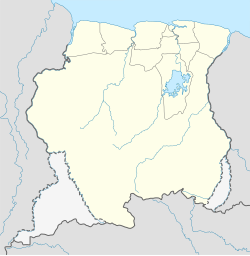Alfonsdorp
Alfonsdorp
Tibiti | |
|---|---|
Village | |
| Coordinates: 5°33′11″N 54°09′44″W / 5.553056°N 54.162222°W | |
| Country | |
| District | Marowijne District |
| Resort | Albina |
| Government | |
| • Captain | Margriet Biswane[1] |
| Population | |
| • Total | 315 |
Alfonsdorp (Lokono: Tibiti[2]) is a village of indigenous Lokono people[1] in the Albina resort of the Marowijne District of Suriname. The village is located on the East-West Link.[3] The Wanekreek Nature Reserve is located near the village.
Overview
[edit]Alfonsdorp has been named after their former village chief Alfons.[4] During the Surinamese Interior War, the village was caught between the Suriname National Army and the Jungle Commando. Most of the village fled to Balaté near Saint-Laurent-du-Maroni, French Guiana.[5] On 29 november 1986, when Moiwana was attacked by the Army, civilians were murdered in Alfonsdorp as well,[6] and the village was destroyed.[5] After a meeting with Thomas Sabajo of the Tucayana Amazonas and Ronnie Brunswijk of the Jungle Commando their safety was assured, and people started to return to their former home.[5]
The village has a school.[7] There used to be a clinic, but as of 2014, it was no longer in operation.[8] In 2018, a catholic church was constructed.[9] An ecotourism resort is located in the village.[4] In 2014, Margriet Biswane was elected village chief.[10] In August 2021, Alfonsdorp was connected to the electricity grid and received 24 hours of electricity.[11]
Wanekreek Nature Reserve
[edit]

Wanekreek is a protected area of Suriname. It measures 45,000 ha (110,000 acres) and contains swamps, savannas, and marsh forests. It has been protected since 1986.[12] The area is rich in wildlife, and is the breeding grounds for orange-winged amazons.[13]
The Wane Creek which lends its name to the nature reserve, connects the Marowijne with the Cottica River and was part of the inland waterway between the Marowijne and Paramaribo.[14] A large bauxite concession is located near the nature reserve.[12]
The nature reserve is in an ongoing dispute with the indigenous villages of Marijkedorp and Alfonsdorp who consider it part of their hunting and fishing grounds.[15] The area however has been uninhibited since the 1950s.[16]
References
[edit]- ^ a b c "Dorpen en Dorpsbesturen". Vereniging van Inheemse Dorpshoofden (in Dutch). Retrieved 22 February 2021.
- ^ "Gebied". Alfonsdorp.nl (in Dutch). Retrieved 22 February 2021.
- ^ "Persoonlijke inzet van onze Vice-President Ronnie Brunswijk". Suriname.nu (in Dutch). Retrieved 21 February 2021.
- ^ a b "Interview: Nico Hermans". Groen Rood Wit (in Dutch). Retrieved 22 February 2021.
- ^ a b c "In memoriam Theodorus Emanuel Blanca". Star Nieuws (in Dutch). Retrieved 17 January 2022.
- ^ "VN-rapporteur bezorgd over mensenrechten in Suriname". Nederlands dagblad (in Dutch). 28 January 1988. Retrieved 17 January 2022.
- ^ Plan Bureau 2014, p. 128.
- ^ Plan Bureau 2014, p. 130.
- ^ "Bouwproject kerk Alfonsdorp afgerond". Omhoog (in Dutch). Retrieved 22 February 2021.
- ^ "Alfonsdorp krijgt nieuwe kapitein". Dagblad Suriname (in Dutch). Retrieved 22 February 2021.
- ^ "Alfonsdorp beschikt nu over 1×24 uur stroom" (in Dutch). 22 August 2021. Retrieved 17 January 2022.
- ^ a b Ouboter 2001, p. 49.
- ^ Ouboter 2001, p. 50.
- ^ "Encyclopaedie van Nederlandsch West-Indië" (PDF). Digital Library for Dutch Literature (in Dutch). 1916. p. 413. Retrieved 22 February 2021.
- ^ Vereniging van Inheemse Dorpshoofden (October 2009). "Securing Indigenous Peoples' Rights in Conservation in Suriname" (PDF). Forest Peoples. p. 53. Retrieved 22 February 2021.
- ^ Vereniging van Inheemse Dorpshoofden (January 2008). "Nature Reserves within the Indigenous Territory of the Kaliña and Lokono Peoples of Lower Marowijne" (PDF). Forest Peoples. p. 4. Retrieved 22 February 2021.
Bibliography
[edit]- Ouboter, Paul E. (2001). "Directory of protected areas of Suriname". IBER.
- Plan Bureau (2014). "Planning Office Suriname - Districts 2009-2013" (PDF). Planning Office Suriname (in Dutch).
External links
[edit]- Village website (in Dutch)


